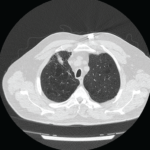Musculoskeletal ultrasound can be an important tool in confirming the diagnosis of knuckle pads. On gray-mode sonography, knuckle pads are hypoechoic, subcutaneous masses with ill-defined margins that are usually non-compressible.5 Doppler usually does not show any hypervascularity in the nodule, although peripheral hypervascularity has been rarely reported.6 The underlying joint and tendon are usually normal. Histopathology of knuckle pads reveals myofibroblast proliferation and decreased elastic filaments in the dermis. The epidermis and corneum are normal.5
Similar to our case, knuckle pads in association with Dupuytren’s contractures have been reported.2 Dupuytren’s contractures are secondary to fibrous thickening of the palmar fascia, leading to firm palmar nodules and cords. On musculoskeletal ultrasound, these subcutaneous nodules in the palmar fascia are directly superficial to the flexor tendons and appear hypoechoic. Hypervascularity on color Doppler is usually absent and the lesions are non-compressible. Typically, the length of these lesions is greater than the width.7
In contrast, flexor tenosynovitis of the flexor tendons of the hands appears as a hypoechoic or anechoic compressible swelling around the tendon (i.e., visible both above and beyond the tendon) with increased color Doppler signal and is accompanied by thickening and loss of the normal fibrillar pattern of the tendon.8
Gouty tophi can also appear on the dorsal, as well as the volar, aspect of the PIP joints. They are usually soft to firm and non-tender. Sonographically, they are heterogeneous and can be multilobulated.9 They can contain hyperechoic calcifications with acoustic shadowing.10 The underlying joint may reveal a double contour sign secondary to crystalline deposition on the cartilage surface.11 Juxta-articular erosions may also be seen underneath the tophaceous deposits.9,12 Hypervascularity can be seen around the periphery of the tophus.
Rheumatoid nodules are also painless, soft to firm, non-tender nodules and can appear on the dorsal or volar aspect of the PIP joints. Sonographically, they are homogenous hypoechoic nodules with hyperechoic rims and may have anechoic centers.10 Features of synovitis, such as synovial hypertrophy, effusion and hypervascularity with increased color Doppler uptake, may be present. In addition, periarticular erosions can also be seen, although the nodules themselves are less erosive to the bone, and cortical bone is easily seen underneath the nodule.10
Synovitis of the PIP joints can also mimic knuckle pads. In contrast to knuckle pads, synovitis is associated with pain, tenderness and limited mobility of the PIP joint. Ultrasound reveals effusion, synovial hypertrophy and increased color Doppler signal in the PIP joint.



